| Pages:
1
2
3
..
5 |
JJay
International Hazard
    
Posts: 3440
Registered: 15-10-2015
Member Is Offline
|
|
Oxalyl Chloride Challenge
After my proposed challenge, Total Synthesis of Lysergic Aldehyde, was rejected by the site moderators, I have decided to open up the Oxalyl
Chloride Challenge!
The rules are a little bit different this time around:
1. You must synthesize oxalyl chloride without using any phosphorus compounds.
2. Your synthesis must be performed without using any chemicals that are available only from chemical suppliers. OTC materials and common industrial
chemicals may be used, as can chemicals available from pottery suppliers, photo suppliers, cleaning suppliers, grocery stores, welding stores, garden
stores, hardware stores, etc. Obviously, oxalic acid is an acceptable chemical to use in your synthesis, but anything as exotic as sodium borohydride
is out. You can use chemicals successfully made by amateurs such as sodium, bromine, nitric acid, etc.
3. Your synthesis must not produce any phosgene as a byproduct.
4. If more than one submission is received, the submissions will be ranked according to how convenient they are and how easy it is to obtain the
materials required, with the winning submission receiving the prize.
5. I reserve the right to close the competition before any submissions are received by producing oxalyl chloride in my own lab.
6. Once a documented synthesis of oxalyl chloride has been submitted, the contest will close within one one week if no further submission is made. If
more than one submission is received, the contest will close exactly 7 days after the last submission.
7. Submissions will only be accepted if they document an actual synthesis of oxalyl chloride.
Possibly useful threads:
OTC Oxalyl Chloride Challenge
Modified Patent Route to Oxalyl Chloride
The prize will be some quartz labware. Oh and also bragging rights. Lots of them. All submissions should be attached to this thread. Questions can be
asked here or via U2U.
|
|
|
Magpie
lab constructor
    
Posts: 5939
Registered: 1-11-2003
Location: USA
Member Is Offline
Mood: Chemistry: the subtle science.
|
|
This is a worthy challenge. I will not submit my entry using homemade SOCl2.
The single most important condition for a successful synthesis is good mixing - Nicodem
|
|
|
Tsjerk
International Hazard
    
Posts: 3036
Registered: 20-4-2005
Location: Netherlands
Member Is Offline
Mood: Mood
|
|
@Magpie; you would lose big time from my super OTC and easy method anyway 
I actually have an idea... I just have to get some anhydrous oxalic acid and something else. Should be easy to test on a gram scale whether it is
worth pursuing.
I'm actually quite broke at the moment and in the foreseeable future... could anyone spare a couple grams of oxalic acid? I will post the photos here
in case of failure, as I think the reaction is interesting anyway.
|
|
|
JJay
International Hazard
    
Posts: 3440
Registered: 15-10-2015
Member Is Offline
|
|
I have about 4500 grams of oxalic acid dihydrate and can easily send someone 10 grams or so if that would be helpful....
I've never made it, but the synthesis from sucrose looks pretty straightforward: https://www.youtube.com/watch?v=M5bAbvw6IQQ
|
|
|
Tsjerk
International Hazard
    
Posts: 3036
Registered: 20-4-2005
Location: Netherlands
Member Is Offline
Mood: Mood
|
|
Ok, nevermind, I just found a 100 gram source for about 10 euros including shipping
|
|
|
clearly_not_atara
International Hazard
    
Posts: 2829
Registered: 3-11-2013
Member Is Online
Mood: Big
|
|
Maybe you can go via glyoxylic chloride, and chlorinate this to get the product? Glyoxylic acid is not the easiest target, but it is doable. You can
form the anhydride by any of the standard procedures (S/Br2, S2Cl2, NO2, etc) and gas this with HCl, or you can try the unproven nitrile method:
bubble HCl through a mixture of 2 parts benzonitrile to 1 part glyoxylic acid, giving glyoxylic acid (glyoxylyl?) chloride and N-benzoylbenzamidinium
chloride.
|
|
|
Magpie
lab constructor
    
Posts: 5939
Registered: 1-11-2003
Location: USA
Member Is Offline
Mood: Chemistry: the subtle science.
|
|
@Tsjerk: May we see the equation, please.
The single most important condition for a successful synthesis is good mixing - Nicodem
|
|
|
chemplayer...
Legendary
  
Posts: 191
Registered: 25-4-2016
Location: Away from the secret island
Member Is Offline
Mood: No Mood
|
|
One question, what's sort of 'proof of completion' is required, i.e. tests or quality criteria that need to be considered to say that oxalyl chloride
has been produced?
|
|
|
JJay
International Hazard
    
Posts: 3440
Registered: 15-10-2015
Member Is Offline
|
|
One of the best ways to demonstrate that oxalyl chloride has been created would be to make TCPO and use it in a glowstick-type demonstration. Of
course, other methods could be acceptable.... The synthesis should be repeatable and considered valid by a consensus (or at least an overwhelming
majority) of amateur scientists.
|
|
|
theAngryLittleBunny
Hazard to Others
  
Posts: 130
Registered: 7-3-2017
Location: Austria
Member Is Offline
Mood: No Mood
|
|
Oh wow, that sounds pretty cool, I think I have a way that would be pretty easy if it would work, and I don't see how it shouldn't work, so I'll give
it a try!
|
|
|
JJay
International Hazard
    
Posts: 3440
Registered: 15-10-2015
Member Is Offline
|
|
I'm glad there is so much interest in this challenge. I'd appreciate it if a moderator would sticky this thread.
|
|
|
j_sum1
|
Thread Topped
4-5-2018 at 20:56 |
Tsjerk
International Hazard
    
Posts: 3036
Registered: 20-4-2005
Location: Netherlands
Member Is Offline
Mood: Mood
|
|
Yeah! This morning my oxalic acid dihydrate came in. I did a really quick and definitely dirty dehydration by putting between 5 and 10 grams in the
microwave. This works, is fast, but please don't do it in your mothers kitchen and stay up-wind. Probably some carbon monoxide was formed.
There were a lot of fumes, the oxalic acid partly burned, but it only took two minutes to get a couple of grams of nicely sublimated acid.
What I did was putting a glass bowl on top of another bowl with the two open sides onto each other. After 30 seconds the acid dissolved in its own
water while starting to boil, after two minutes in the microwave there was no more oxalic in the bottom of the bottom bowl, except for a bit of
completely carbonized acid, and a grayish ring where the acid started to condense (what is the correct term for this? From gas to solid?) Above this
grey ring there were nice white crystals of presumable anhydrous acid. I scraped all white fluffy crystals off of the glass, the gray and black stuff
were discarded.
The yield is probably below 50%, but I have enough anhydrous acid for the tests I want to do; hopefully this afternoon. Next time I will try if I can
do it a little cleaner by halving the microwave power, do it in shorter burst while cooling the top bowl with some ice in between heating.
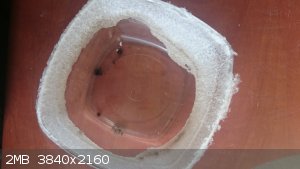
Bottom bowl, note that the bottom where the acid was is now completely clean (well, almost clean).
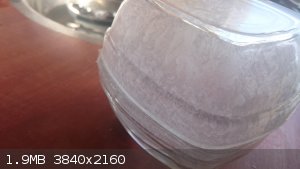
Two bowls like they were while microwaving
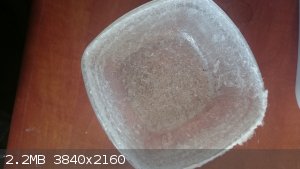
Top bowl after microwaving
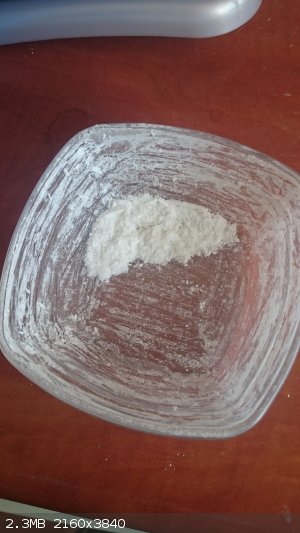
Recovered fluffy white crystals
|
|
|
Texium
Administrator
       
Posts: 4673
Registered: 11-1-2014
Location: Salt Lake City
Member Is Offline
Mood: Preparing to defend myself (academically)
|
|
Wow, that's really nice. A lot cleaner than when I dehydrated some in a toaster oven once. More reason for me to see about getting a lab microwave at
Goodwill.
|
|
|
Tsjerk
International Hazard
    
Posts: 3036
Registered: 20-4-2005
Location: Netherlands
Member Is Offline
Mood: Mood
|
|
The field was a bit lower than I thought, I only scraped out 0.6 grams. Maybe a microwave with a hole in the top with a non-cooled condensor would be
an idea.
I think I might have made something condensable chlorinated, fuming in the air, turning into a white solid upon exposure to moist air, today.
What I did was dissolving TCCA in concentrated sulfuric acid, cooled it to 5 degrees, added my 0.6 grams of anhydrous oxalic acid, then let it warm
(nothing exothermic) to RT, warmed it to 60-80 degrees.
What I saw was bubbling and fumes from 60 degrees and up. I put a round bottom flask with ice water on top of the beaker
There was definitly chlorine gas coming off, but also some condensate on the round bottom.
The condensate(quite viscous) left a white precipitate after fuming in the air (I swapped the ice water for hot water).
My guesses are that the fume cannot be oxalic acid, as chlorine would oxidize that quickly, it can also not be water, as it was coming of concentrated
sulfuric. The fumes were definitly HCl, as those are unmistakable.
Now the question is, what was condensing? It was coming of from 60 degrees and up (I overdid the heating big time), it was turning solid upon exposure
to air. Could there be some cyanuric something evaporation? I heated the sulfuric to 90 degrees to get the TCCA to dissolve before adding the oxalic
acid, no fumes there.
I will post pictures in a bit.
|
|
|
JJay
International Hazard
    
Posts: 3440
Registered: 15-10-2015
Member Is Offline
|
|
Be careful.
|
|
|
Tsjerk
International Hazard
    
Posts: 3036
Registered: 20-4-2005
Location: Netherlands
Member Is Offline
Mood: Mood
|
|
https://www.google.nl/amp/s/www.researchgate.net/publication...
[Edited on 5-5-2018 by Tsjerk]
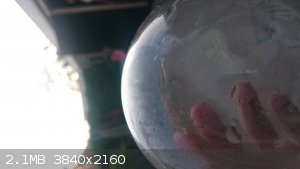 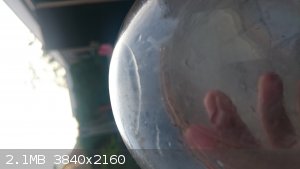
|
|
|
theAngryLittleBunny
Hazard to Others
  
Posts: 130
Registered: 7-3-2017
Location: Austria
Member Is Offline
Mood: No Mood
|
|
Quote: Originally posted by Tsjerk  | The field was a bit lower than I thought, I only scraped out 0.6 grams. Maybe a microwave with a hole in the top with a non-cooled condensor would be
an idea.
I think I might have made something condensable chlorinated, fuming in the air, turning into a white solid upon exposure to moist air, today.
What I did was dissolving TCCA in concentrated sulfuric acid, cooled it to 5 degrees, added my 0.6 grams of anhydrous oxalic acid, then let it warm
(nothing exothermic) to RT, warmed it to 60-80 degrees.
What I saw was bubbling and fumes from 60 degrees and up. I put a round bottom flask with ice water on top of the beaker
There was definitly chlorine gas coming off, but also some condensate on the round bottom.
The condensate(quite viscous) left a white precipitate after fuming in the air (I swapped the ice water for hot water).
My guesses are that the fume cannot be oxalic acid, as chlorine would oxidize that quickly, it can also not be water, as it was coming of concentrated
sulfuric. The fumes were definitly HCl, as those are unmistakable.
Now the question is, what was condensing? It was coming of from 60 degrees and up (I overdid the heating big time), it was turning solid upon exposure
to air. Could there be some cyanuric something evaporation? I heated the sulfuric to 90 degrees to get the TCCA to dissolve before adding the oxalic
acid, no fumes there.
I will post pictures in a bit.
|
Be a bit more careful, what you did sounds quite dangerous tbh, because the chlorine could oxidize the oxalic acid, making stuff like phosgene. You
don't need chlorine for that, because you don't wanna oxidize the oxalic acid, you need chloride which replaces the OH groups on the oxalic acid, like
PCl5, SOCl2, stuff like that. And don't confuse TCCA with cyanuric chloride, they are not the same, not at all.
|
|
|
Tsjerk
International Hazard
    
Posts: 3036
Registered: 20-4-2005
Location: Netherlands
Member Is Offline
Mood: Mood
|
|
I know, I know, it was not my intention to generate chlorine. I was hoping it would not evolve. I do think there is something here as I got a
condensate while there was chlorine. It is not a question if chlorine will oxidize oxalic, it will for sure, definitely at 60 degrees.
Edit: Oxalyl cloride should be stable though in hot sulfuric and or chlorine
[Edited on 5-5-2018 by Tsjerk]
|
|
|
theAngryLittleBunny
Hazard to Others
  
Posts: 130
Registered: 7-3-2017
Location: Austria
Member Is Offline
Mood: No Mood
|
|
Quote: Originally posted by Tsjerk  | I know, I know, it was not my intention to generate chlorine. I was hoping it would not evolve. I do think there is something here as I got a
condensate while there was chlorine. It is not a question if chlorine will oxidize oxalic, it will for sure, definitely at 60 degrees.
Edit: Oxalyl cloride should be stable though in hot sulfuric and or chlorine
[Edited on 5-5-2018 by Tsjerk] |
Still tho, the problem is that you used chlorine in the +1 oxidation state, but you need chlorine in the -1 oxidation state. For your reaction to
work, it would have to generate trihydroxyisocyanuric acid, and I don't think that exists. I think treating carbon compounds where the carbon is in a
higher oxidation state like +2, +3 with chlorine is always risky, because it could generate phosgene.
|
|
|
mackolol
Hazard to Others
  
Posts: 459
Registered: 26-10-2017
Member Is Offline
Mood: Funky
|
|
Hi, today i tried synthesis of oxalyl chloride by chlorination of ethylene glycol. I have read an article about that and says that yield is nearly
100% if used solvent. They used o-dichlorobenzene. I have chosen tetrachloroethylene as it dissolves chlorine well and boils at 120C. So i attempted
synthesis with my fresh obtained TCE. At the beginning everything was ok mixture turned green because of dissolved chlorine and heated. But as it was
going it became cloudy and eventually it formed big crystal that blocked my magnetic stirrer. I found that it was hexachloroethane as it smelled the
same and it was only option. So my question is how it was chlorinated to HCE if doug was attempting this with catalyst and under reflux and it almost
didnt work and every patent says that it requires very strong light and other shit like that. I can also say that this was performed outside under
daylight. Can anybody explain this and help what to do with this solvent?
|
|
|
Dr.Bob
International Hazard
    
Posts: 2819
Registered: 26-1-2011
Location: USA - NC
Member Is Offline
Mood: Mildly disgruntled scientist
|
|
Did you simply chlorinate the solvent TCE to add Cl across the double bond? Not sure how easy that is, but seems quite likely. That may be why
they use o-dichlorobenzene as the solvent, as it is less likely to chlorinate in those conditions.
|
|
|
weilawei
Hazard to Others
  
Posts: 130
Registered: 3-12-2017
Member Is Offline
Mood: No Mood
|
|
Quote: Originally posted by theAngryLittleBunny  | Quote: Originally posted by Tsjerk  | I know, I know, it was not my intention to generate chlorine. I was hoping it would not evolve. I do think there is something here as I got a
condensate while there was chlorine. It is not a question if chlorine will oxidize oxalic, it will for sure, definitely at 60 degrees.
Edit: Oxalyl cloride should be stable though in hot sulfuric and or chlorine
[Edited on 5-5-2018 by Tsjerk] |
Still tho, the problem is that you used chlorine in the +1 oxidation state, but you need chlorine in the -1 oxidation state. For your reaction to
work, it would have to generate trihydroxyisocyanuric acid, and I don't think that exists. I think treating carbon compounds where the carbon is in a
higher oxidation state like +2, +3 with chlorine is always risky, because it could generate phosgene. |
1,3,5-trihydroxyisocyanuric acid can be prepared, but it looks like it's not a simple procedure from quick searching. See here.
Edit: Aaaand here's the paper.
[Edited on 14-5-2018 by weilawei]
Attachment: THICA.pdf (261kB)
This file has been downloaded 1171 times
|
|
|
clearly_not_atara
International Hazard
    
Posts: 2829
Registered: 3-11-2013
Member Is Online
Mood: Big
|
|
| Quote: | I think I might have made something condensable chlorinated, fuming in the air, turning into a white solid upon exposure to moist air, today.
What I did was dissolving TCCA in concentrated sulfuric acid, cooled it to 5 degrees, added my 0.6 grams of anhydrous oxalic acid, then let it warm
(nothing exothermic) to RT, warmed it to 60-80 degrees.
What I saw was bubbling and fumes from 60 degrees and up. I put a round bottom flask with ice water on top of the beaker
There was definitly chlorine gas coming off, but also some condensate on the round bottom.
The condensate(quite viscous) left a white precipitate after fuming in the air (I swapped the ice water for hot water).
My guesses are that the fume cannot be oxalic acid, as chlorine would oxidize that quickly, it can also not be water, as it was coming of concentrated
sulfuric. The fumes were definitly HCl, as those are unmistakable.
Now the question is, what was condensing? It was coming of from 60 degrees and up (I overdid the heating big time), it was turning solid upon exposure
to air. Could there be some cyanuric something evaporation? I heated the sulfuric to 90 degrees to get the TCCA to dissolve before adding the oxalic
acid, no fumes there.
|
Two thoughts:
- TCCA is not TCT. TCT converts acids to acyl halides. TCCA is an oxidizer.
- Anyone attempting oxalyl chloride by deoxychlorination of oxalic acid needs a fume hood because dehydration of
oxalic acid can quickly generate a lot of carbon monoxide. At the very least, you should have a carbon monoxide detector installed
and good ventilation. There is no smell warning; you just get a headache, pass out, and die. CO will probably not be formed with TCCA and oxalic acid,
though, thankfully.
|
|
|
JJay
International Hazard
    
Posts: 3440
Registered: 15-10-2015
Member Is Offline
|
|
I will be actively working to synthesize oxalyl chloride next week. I'll check back, and if someone has actually beaten me to the punch then I'll
award the prize, but I have an advantage: under the rules, as the contest sponsor, I am permitted to use phosphorus compounds. So if you have a
winning entry, now is the time to submit it.
|
|
|
morganbw
National Hazard
   
Posts: 561
Registered: 23-11-2014
Member Is Offline
Mood: No Mood
|
|
Somedays I drink and may post when I should be sleeping but here it is.
I did not read that you were allowed to cheat. Think my Harvard Grad!
Too smart to be so stupid.
|
|
|
| Pages:
1
2
3
..
5 |